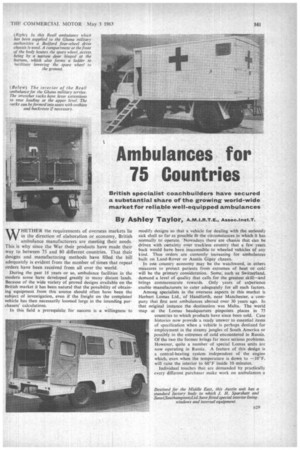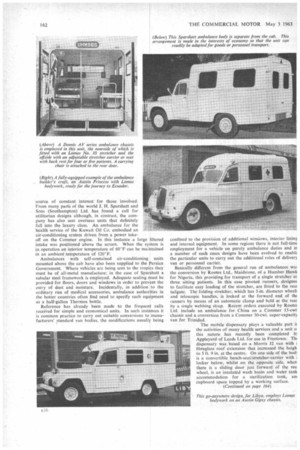Ambulances for 75 Countries
Page 163

Page 164

Page 166

If you've noticed an error in this article please click here to report it so we can fix it.
British specialist coachbuilders have secured a substantial share of the growing world-wide market for reliable well-equipped ambulances By Ashley Taylor, A.M.I.R.T.E., Assoc.! net.T.
WHETHER the requirements of overseas markets lie in the direction of elaboration or economy, British ambulance manufacturers are meeting their needs. This is why since the War their products have made their way to between 75 and 80 different countries. That their designs and manufacturing methods have filled the bill adequately is evident from the number of times that repeat orders have been received from all over the world.
During the past 18 years or so, ambulance facilities in the modern sense have developed greatly in many distant lands. Because of the wide variety of proved designs available on the British market it has been natural that the possibility of obtaining equipment from this source should often have been the subject of investigation, even if the freight on the completed vehicle has then necessarily loomed large in the intending purchasers calculations.
In this field a prerequisite for success is a willingness to
modify designs so that a vehicle for dealing with the seriously sick shall so far as possible fit the circumstances in which it has normally to' operate. Nowadays there are chassis that can be driven with certainty over trackless country that a few years back would have. been inaccessible to wheeled vehicles of any kind. Thus orders are currently increasing for ambulances built on Land-Rover or Austin Gipsy chassis.
In one country economy may be the watchword, in others measures to protect patients from extremes of heat or cold will be the primary consideration. Some, such as Switzerland, demand a level of quality that calls for the greatest skill—and brings commensurate rewards. Only years of experience enable manufacturers to cater adequately for all such factors.
Among specialists in the overseas aspects in this market is Herbert Lomas Ltd., of Handforth, near Manchester, a company that first sent ambulances abroad over 30 years ago. In that original instance the destination was Malta. The world map at the Lomas headquarters pinpoints places in 75 countries to which products have since been sold. Case histories now provide a ready answer to essential items of specification when a vehicle is perhaps destined for employment in the steamy jungles of South America or possibly in the extremes of cold encountered in Russia. Of the two the former brings far more serious problems. However, quite a number of special Lomas units are now operating in Russia. A feature of this design is a central-heating system independent of the engine which, even when the temperature is down to —10'F, will raise the interior to 60°F inside 10 minutes.
Individual touches that are demanded by practically every different purchaser make work on ambulances a source of constant interest for those involved. From many parts of the world J. H. Sparshatt and Sons (Southampton) Ltd. has found a call for utilitarian designs although, in contrast, the company has also sent overseas units that definitely fall into the luxury class. An ambulance for the health service of the Kuwait Oil Co. embodied an air-conditioning system driven from a power takeoff on the Commer engine. In this instance a large filtered intake was positioned above the screen. When the system is in operation an interior temperature of 60°F can be maintained in an ambient temperature of 120°F.
Ambulances with self-contained air-conditioning units mounted above the cab have also been supplied to the Persian Government. Where vehicles are being sent to the tropics they must be of all-metal manufacture; in the case of Sparshatt a tubular steel framework is employed. Adequate sealing must be provided for floors, doors and windows in order to prevent the entry of dust and moisture. Incidentally, in addition to the ordinary run of medical accessories, ambulance authorities in the hotter countries often find need to specify such equipment as a half-gallon Thermos bottle.
Reference has already been made to the frequent calls received for simple and economical units. In such instances it is common practice to carry out suitable conversions to manufacturers' standard van bodies, the modifications usually being confined to the provision of additional windows, interior lining and internal equipment. In some regions there is not full-time employment for a vehicle on purely ambulance duties and in a number of such cases designs have been evolved to enable the particular units to carry out the additional roles of delivery van or personnel carrier.
Basically different from the general run of ambulances was the conversion by Rootes Ltd.. Maidstone. of a Humber Hawk for Nigeria, this providing for transport of a single stretcher Of three sitting patients. In this case pivoted runners, designec to facilitate easy loading of the stretcher, are fitted to the rear tailgate. The folding stretcher, which has 3-in, diameter wheels and telescopic handles; is locked at the forward end of the runners by means of an automatic clamp and held at the rear by a single webbing strap. Recent orders executed by Rootes Ltd. include an ambulance for China on a Commer 15-cwt chassis and a conversion from a Commer 30-cwt. super-capacity van for Trinidad.
The mobile dispensary plays a valuable part is the activities of many health services and a unit o this nature has recently been completed b! Appleyard of Leeds Ltd. for use in Freetown. Ths dispensary was based on a Morris J2 van with ; fibreglass roof extension that increased the heigh to 5 ft. 9 in. at the centre. On one side of the bod! is a convertible bench-seat/stretcher-carrier with ; locker below, whilst on the opposite side. when there is a sliding door just forward of the rea wheel, is an insulated wash basin and water tank accommodation for a sterilization tank, am cupboard space topped by a working surface.
With the aid of ambulance building experience extending over more than 50 years, the products of Dennis Bros. Ltd., Guildford, have achieved a considerable overseas distribution, the vehicles being in use in such. places as Singapore, 'Johannesburg, Salisbury (Southern Rhodesia), Stilfontein (S. Africa), Cape Town, Andola and Bahrain.
In military circles some interest attaches to the ambulance on the Bedford four-wheel drive chassis which Beall Coachbuilders Ltd. has been supplying in substantial numbers to the army of Ghana. A bulkhead is fitted across the front of the saloon to house the spare wheel, access being from outside by means of a door hinged at the bottom. When opened this forms a ladder that facilitates the lowering of the wheel to the ground. Over the wheel locker are two cupboards that accommodate medical supplies or radio. Customary equipment includes blood plasma bottles, drinking water tank with tap and two glasses in adjacent brackets, a detachable first aid box and a detachable splint box.
Around the World The fact that nearly every territory demands something different spells a whole host of problems for manufacturers such as the Lomas organization whose net, as has been indicated earlier, is cast exceptionally wide. Examining customers' locations at random one encounters the names of Tonga, Bulgaria, Greece, Borneo, Uganda, Burma, Portugal, Australia, Madeira, Formosa, Ecuador, Russia, Spain, Yugoslavia, Syria. Iceland, the Faroes, Venezuela, Angola, Iraq, Turkey, Paraguay, Aden, Hong Kong, Siam, Quatar and New Zealand. And .there are many more. Each territory has its own ideas about its particular requirements and it is the job of manufacturer and designer to bring them to fruition or to suggest more practical alternatives.
Tropicalization of materials takes a number of different forms, the experienced designer quickly being able to assess the requirements for any given set of conditions. All are agreed that the most difficult jobs are those intended for service in the East. In South America, Ecuador is a country with an extremely difficult climate where for something like a third of the year great humidity is registered. For the hotter climes, of course, timber construction is out.
When I was at the Lomas works a sharp-eyed visitor pointed out that wood was being employed in what was nominally an all-metal body. This, however, proved only to be a necessary supporting element required in forming the window apertures. Within three months of the particular ambulance being placed E32 in service the local termites would obligingly have consuma that wood, so leaving all precisely according to specification Double-skinned throughout, bodywork for overseas countrie will normally carry a thermal interlining which will not onl: assist in retaining the interior temperature, whether condition outside are hotter or colder, but will also ensure a measure o acoustic insulation. Various products are employed for thi purpose, a popular choice being a fine glass-fibre mat. Canva and upholstery materials must be treated so that they are re and insect resistant. If flying insects are likely to prove problem, fine wire mesh protectors must be fitted over th sliding windows.
The development of the National Health Service in Brita. has accustomed manufacturers to a high percentage hom demand for sitting-case ambulances, or alternatively for dual purpose designs, but in the export sphere this trend is mud less in evidence. All the figures quoted to me suggest that nc less than 90 per cent of the orders received are in respect o fully-equipped units for stretcher cases.
Various degrees of air conditioning are commonplace wit overseas orders, twin fans that are adjustable in relation t stretchers on either side being a regular feature. Most ambu lance equipment is international in its application—the flashin blue beacon, the roof-mounted spotlight, the radio appliances– but constant vigilance must be exercised by the makers t ensure that these vehicles on a primary public service sha not in any way transgress the purchasing country's own reguIa tions. Early need for modification would be poor publicit for British products.




















































































































































































































































